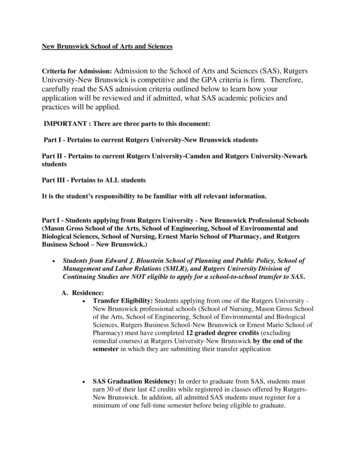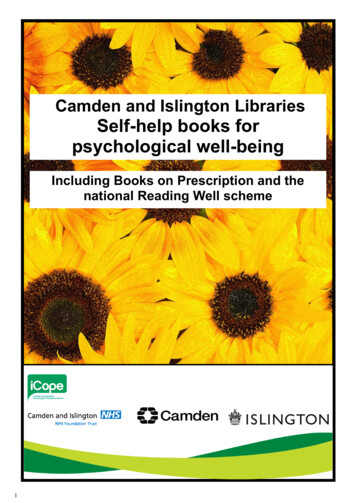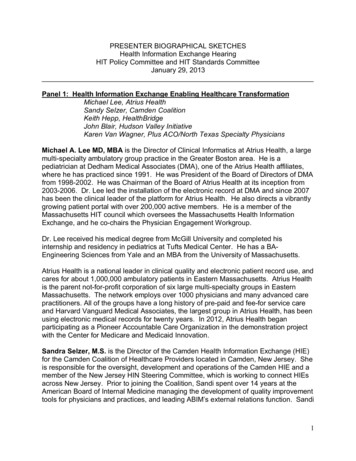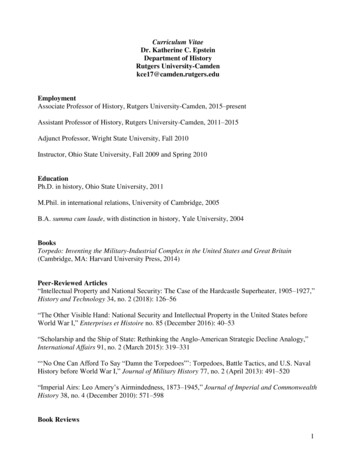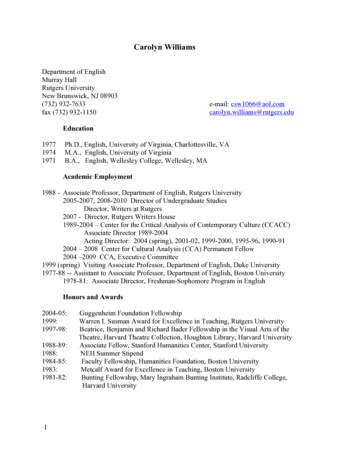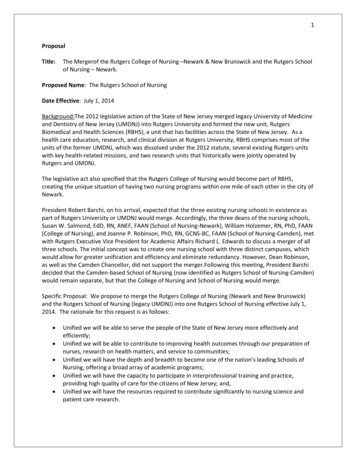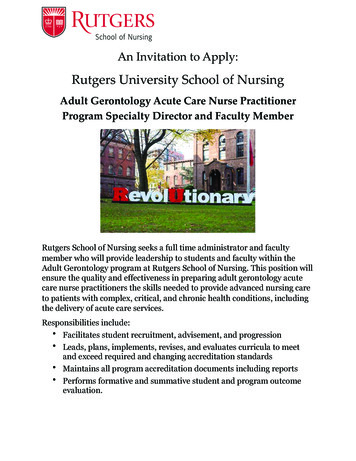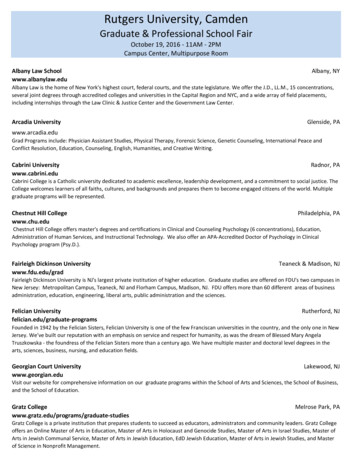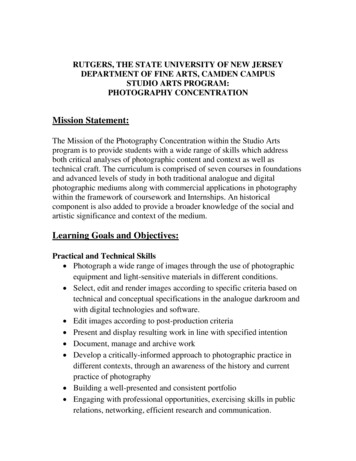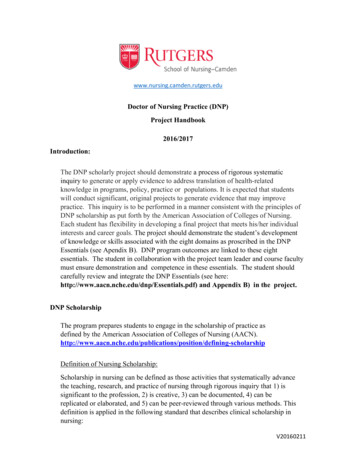
Transcription
www.nursing.camden.rutgers.eduDoctor of Nursing Practice (DNP)Project Handbook2016/2017Introduction:The DNP scholarly project should demonstrate a process of rigorous systematicinquiry to generate or apply evidence to address translation of health-relatedknowledge in programs, policy, practice or populations. It is expected that studentswill conduct significant, original projects to generate evidence that may improvepractice. This inquiry is to be performed in a manner consistent with the principles ofDNP scholarship as put forth by the American Association of Colleges of Nursing.Each student has flexibility in developing a final project that meets his/her individualinterests and career goals. The project should demonstrate the student’s developmentof knowledge or skills associated with the eight domains as proscribed in the DNPEssentials (see Apendix B). DNP program outcomes are linked to these eightessentials. The student in collaboration with the project team leader and course facultymust ensure demonstration and competence in these essentials. The student shouldcarefully review and integrate the DNP Essentials (see here:http://www.aacn.nche.edu/dnp/Essentials.pdf) and Appendix B) in the project.DNP ScholarshipThe program prepares students to engage in the scholarship of practice asdefined by the American Association of Colleges of Nursing ion/defining-scholarshipDefinition of Nursing Scholarship:Scholarship in nursing can be defined as those activities that systematically advancethe teaching, research, and practice of nursing through rigorous inquiry that 1) issignificant to the profession, 2) is creative, 3) can be documented, 4) can bereplicated or elaborated, and 5) can be peer-reviewed through various methods. Thisdefinition is applied in the following standard that describes clinical scholarship innursing:V20160211
Clinical Scholarship (AACN):Clinical scholarship focuses on the translation of new science, its application andevaluation. DNP graduates also generate evidence through their practice to guideimprovements in practice and outcomes of care providing leadership for evidencebased practice. This requires competence in knowledge application activities: thetranslation of research in practice, the evaluation of practice, improvement of thereliability of health care practice and outcomes, and participation in collaborativeresearch (DePalma & McGuire, 2005).Purpose and Aims of the DNP Project:The Rutgers School of Nursing-Camden supports and approves DNP projects that seek toinform practice or policy in ways that may lead to improved healthcare outcomes forindividuals and populations. These projects must seek to inform efforts to achievesustainable improvement in the delivery of care for individuals and populations.DNP projects may incorporate various approaches. These include specific improvementprojects (translation of research) that measure outcomes associated with evidence-basedinnovations introduced into particular healthcare settings or populations. Specific aims ofthe DNP project should incorporate evidence to inform practice. These innovations areusually informed by external evidence that is generated through research or reportedoutcomes in practice settings.Projects may also be designed to generate health or healthcare improvement, apply andevaluate knowledge or evidence, in community settings. These projects may explorephenomena that can be linked to develop strategies to improve care of individuals orpopulations. The design and structure of these projects must be logically linked to somepotential improvement in population health and the delivery of healthcare services.Students may utilize a variety of methods to support inquiry in the project. These methodsmay include qualitative as well as quantitative techniques.DNP Project Team: The DNP project team is responsible for supporting, overseeingand approving DNP project work. Early in the program (before the start of scholarlyseminar I). The student will need to consult with the Graduate Director in order toobtain guidance in identifying a project team, and final approval of their DNP projectteam leader. Ideally the project team will consist of members with the appropriatemethodological and clinical expertise.DNP Advisor/Team leader and Second Faculty Team Member:The DNP project team advisor/team leader will be a standing member of the faculty at theRutgers School of Nursing-Camden and will have an earned doctorate. This person hasthe ultimate responsibility to support, oversee and approve the student’s DNP project.Each student should consult with their DNP team leader regarding the inclusion of aV20160211
second faculty member to serve on the team. The second team member should be able toprovide additional support and insight into the DNP project. The DNP team leadershould have a team meeting soon after the formation of the team to discuss roles andresponsibilities of the team.Students may need to seek outside support to improve skills such as writing and accessingthe appropriate literature. It will be the responsibility of the student to obtain thenecessary support services to improve these skills.DNP Clinical PartnerAll DNP projects must have an external clinical partner. The clinical partner should haveexpertise in the content area. This individual(s) should also have legitimate standingwithin the population/practice setting in which the project is conducted. The clinicalpartner should be able to adequately support the project within the DNP projectsetting.The team leader will work collaboratively with the student to identify a clinicalpartner.Development and Progression of the DNP Scholarly ProjectCoursePrior to takingFoundations ofNursing Practiceand EvidenceBased PracticeBegin to work with facultyadvisors to identify aquestion/projectXBy the completion ofscholarly seminar I (seerequired elements of theproject proposal paper below)By the completionof ScholarlySeminar IIBy thecompletion ofScholarlySeminar IIIBegin background readingthat relates to the projectIdentify broad interest areaEstablish Gap in EvidenceXIdentify practice/populationXEstablish DNP project teamformation including: Projectteam leader, a second facultyteam member and the projectclinical partner (person at theproject site who has theexpertise and legitimate powerto support the success of theproject).XDNP project team will workcollaboratively with thescholarly seminar 1 faulty todevelop the project plan. TheScholarly seminar 1 facultywill approve the paper thatoutlines the scholarly projectby the end of this course.(See requirements for DNPV20160211
project plan proposal inappendix A.)CITI Training (copy ofsuccessful completion recordprinted and included as anaddendum to the projectproposal paper.)X(This includes assuring allfaculty team members arecompliant.)IRB PreparationXProposal defenseXIRB submissionX (occurs between seminar Iand seminar II)IRB approval priorto the start ofScholarly Seminar IIDNP scholarly projectimplementationXData/outcome analysisXProject evaluation (facilitatorsand barriers)XDNP Scholarly ProjectDefenseXDissemination of findings:Paper presentationPoster presentationManuscript developmentDNP Scholarly Project Proposal Defense:1. The project team leader along with the seminar 1 faculty should be involved in thedevelopment of the project plan in an ongoing manner. This will ensure that thestudent is making the necessary changes and modifications during seminar 1.2. The project team leader is responsible for sharing the project plan paper withmembers of the project team (including the project clinical partner). Teammembers should be afforded a minimum of two weeks to provide suggestions andfeedback.3. The seminar 1 faculty should support the quality of the writing of the project planbut it is the responsibility of the project team leader to approve the plan.4. Once the plan is approved by the project team leader an oral presentation of theproject plan can be scheduled. All members of the project team should be inattendance at this presentation. Feedback at this point should serve to help theV20160211
student improve their presentation of the plan. There should not be any need forsubstantive changes on the part of the student once the project plan is approved bythe project team leader.5. Once approved, the DNP Scholarly Project Approval Form (Appendix B) must besigned by all team members and placed in the official academic folder.6. Students and faculty team mebers are required to successfully pass the CITIcertification exam in order to submit a proposal to the IRB(https://www.citiprogram.org/Default.asp?). Students must also apply for an IRBaccount as per Rutgers University policy.7. 7. IRB approval is required before proceeding with any aspect of the project(students should consult with the project team leader to ensure that there is noviolation of this requirement). IRB approval is a lengthy process requiring multiplelevels of approval including departmental and university.Outline of the DNP Project Process:The student is expected to follow a structured process in developing, implementing anddisseminating the findings from the DNP project. The student is expected to collaboratewith their DNP project team members in a continuous manner throughout the project.Evidence of ongoing contact of the student with the project clinical partner, shared withthe team leader, of the team is advised. The DNP project team leader should establish acontractual timeline with the student that identifies deadlines for important phases of theproject. Once the project has been presented and finalized by the project team, anymodification in the project must be discussed and approved by the DNP project teamleader prior to initiating any change. Any modifications of the protocol requires approvalof the project team and IRB.DNP Scholarly Project Final Oral PresentationSuccessful completion of the DNP Scholarly Project will require approval by the DNPproject Team leader in consultation with the DNP project team. The DNP project teamleader will review the final paper which will be a report that describes the outcomes,analysis and practice recommendations that were generated as a result of implementing theproject.The final project paper should build upon previous written work related to the project.Material from the project proposal should not need to be re-written since it was alreadyapproved. The only exception to this is when there was a need to re-design the project.The additional elements that are needed in the final paper include a section on the datagenerated in the project, an analysis of the data according to the methods described in theproject plan, a synthesis and discussion of the data and strategies for practice or populationhealth or healthcare improvement.DNP Project Residency HoursV20160211
Residency hours are assigned for work completed outside of class that relates to theunique work of the DNP project of a student. Class time and other time that is spent inmeeting the requirements of a course not directly linked to the project may not count asproject residency hours. For post-BSN students it is important to understand thedifference between residency hours that are required for the NP role vs. residency hoursthat are assigned to the DNP project.DNP students should engage proactively with the project team team leader and coursefaculty to develop the project. It is the student’s responsibility to seek guidance andassistance. Project residency hours should be recorded in the Typhon clinical trackingsystem: https://www.typhongroup.net/np/.DNP project residency hours: DNP work will require a total of 360 residency hours inconjunction with the three seminar courses (120 hours of clinical hours per course). Thisdoes not include assigned course-related work). You should consult with the DNP teamteam leader to ensure that these clinical hours logically support the development ofknowledge and skills related to the project.The following activities are some examples of time that can be applied toward residencyhours that are associated with the scholarly seminar courses: Observational, meeting time with identified expertsOrganizational planning meetings to determine goals/approached for projectAttending seminars, meeting with clinical partners related to project problemLearning new skills appropriate to the project topicReviewing the literature, evaluating and appraising evidence for the projectProducing educational materials related to the project topicDeveloping tools for assessment and evaluation related to the project topicEngaging in organizational work related to the projectEngaging in policy development related to projectPoster, paper presentations of findings in agency or at conferenceStaff in-services related to project implementationManuscript preparationAllan, J., Agar Barwick, T., Cashman, S., Cawley, J. F., Day, C., Douglass, C. W., et al.(2004). Clinical prevention and population health: Curriculum framework forhealth professions. American Journal of Preventive Medicine, 27(5), 471-476.Boyer, E. L. (1990). Scholarship reconsidered: Priorities of the professoriate. Princeton, NJ: Carnegie Foundation for the Advancement of Teaching.DePalma, J. A., & McGuire, D. B. (2005). Research. In A.B. Hamric, J. A. Spross, & C.V20160211
Hanson (Eds), Advanced practice nursing: An integrative approach (3rd ed) (pp.257- 300). Philadelphia, PA: Elsevier Saunders.Appenix A.DNP project proposal paper guidelinesThe DNP Project Proposal must be reviewed and approved by the students project team leader incollaboration with other members of the project team (including the on‐site clinical partner), and facultyfrom the Scholarly Seminar 1 Course. This approval by the team leader must occur before the student mayproceed with submission to the IRB.DNP Project Title/OverviewConcise and accurate/Provides direction for the projectProblem Statement/Background and Significance of the Problema.b.c.d.e.Describes the phenomenon, its importance to healthcare and affected stakeholders.Introductory materials with brief evidentiary statement to justify the topic and describe how the projectmight address gaps in the evidence and lead to potential practice improvement.Purpose statement, clearly and concisely states specific aims of the projectClear identification of the question(s) driving the inquiry. The question(s) focuses on translation of science,its application and evaluation, generating evidence through practice to guide improvement or to informpractice or policy related to health or healthcare in a practice or population.If a direct practice‐improvement project, outcome measures must be identified.Review and synthesis of Literaturea.Literature search strategy and databases usedb. Thorough review of the critical analysis of the literaturec. Synthesis of the evidence supporting the clinical question and projectTheoretical Frameworka.b.Description of model or framework to be used to guide the project. This should include nursing theory butmay additionally include organization theories or models.Justification and relevance of the framework to the clinical questionDesign and MethodologyV20160211
a.b.c.d.e.f.g.h.i.j.Project DesignSettingPopulation/SamplingRecruitment strategiesOutcome measuresImplementation/inquiry plansThorough description of implementation or inquiry process.Psychometric properties of any instruments used (reliability and validity)Procedures for data collection (including qualitative methods as appropriate).Project evaluation including a plan for data analysisTime line for projectPractice improvement projects must address issues of sustainabilityOther projects must provide a tentative plan as to how the findings might provide a foundation for furtherwork to improve practice.Organizational Assessment & Cost Effectiveness Analysisa.If a practice improvement project: An assessment of the organization, group or population in which thepractice improvement project will occur. This assessment should include:a. Readiness for changeb. Facilitators and barriersc. Risks and/or unintended consequencesd. Cost factors associated with the projecte. Potential short and long‐term costs of any sustainable practice improvementf. Potential savings associated with implementationIRB Approval (if applicable)a.Draft of IRB proposal which includes the following:a. Potential threats to human subjects and how these potential threats will be handledi. Protected health informationii. Other privacy issuesiii. Burden to participantsTimeframea.b.Reasonable and comprehensiveNegotiate due datesProject reflects and demonstrates the AACN Essentials of Doctoral Education for Advanced Nursing Practicea. Articulate specific essentials that are met with the proposed projectWriting, References, APA Format, Title PageWriting is grammatically correct, crisp, clear, and succinct. The writer incorporates the active voice whenappropriate. Follows current APA format guidelines.V20160211
APPENDIX BEIGHT DNP ESSENTIALSEssential I: Scientific Underpinnings for Practice. The practice doctorate in nursing providesthe terminal academic preparation for nursing practice. The scientific underpinnings of thiseducation reflect the complexity of practice 9 at the doctoral level and the rich heritage thatis the conceptual foundation of nursing.Essential II: Organizational and Systems Leadership for Quality Improvement and SystemsThinking. Organizational and systems leadership are critical for DNP graduates to improvepatient and healthcare outcomes. Doctoral level knowledge and skills in these areas areconsistent with nursing and health care goals to eliminate health disparities and to promotepatient safety and excellence in practice.Essential III: Clinical Scholarship and Analytical Methods for Evidence‐Based Practice.Scholarship and research are the hallmarks of doctoral education. Although basic researchhas been viewed as the first and most essential form of scholarly activity, an enlargedperspective of scholarship has emerged through alternative paradigms that involve morethan discovery of new knowledge (Boyer, 1990). These paradigms recognize that (1) thescholarship of discovery and integration “reflects the investigative and synthesizing traditionsof academic life” (Boyer, p. 21); (2) scholars give meaning to isolated facts and makeconnections across disciplines through the scholarship of integration; and (3) the scholarapplies knowledge to solve a problem via the scholarship of application (referred to as thescholarship of practice in nursing). This application involves the translation of research intopractice and the dissemination and integration of new knowledge, which are key activities ofDNP graduates. The scholarship of application expands the realm of knowledge beyond merediscovery and directs it toward humane ends. Nursing practice epitomizes the scholarship ofapplication through its position where the sciences, human caring, and human needs meetand new understandings emerge.Essential IV: Information Systems/Technology and Patient Care Technology for theImprovement and Transformation of Health Care: DNP graduates are distinguished by theirabilities to use information systems/technology to support and improve patient care andhealthcare systems, and provide leadership within healthcare systems and/or academicsettings. Knowledge and skills related to information systems/technology and patient caretechnology prepare the DNP graduate to apply new knowledge, manage individual andaggregate level information, and assess the efficacy of patient care technology appropriate toa specialized area of practice.Essential V: Health Care Policy for Advocacy in Health Care: Health care policy‐‐whether it isV20160211
created through governmental actions, institutional decision making, or organizationalstandards‐‐creates a framework that can facilitate or impede the delivery of health careservices or the ability of the provider to engage in practice to address health care needs.Thus, engagement in the process of policy development is central to creating a health caresystem that meets the needs of its constituents.Essential VI: Interprofessional Collaboration for Improving Patient and Population HealthOutcomes: Today’s complex, multi‐tiered health care environment depends on thecontributions of highly skilled and knowledgeable individuals from multiple professions. Inorder to accomplish the IOM mandate for safe, timely, effective, efficient, equitable, andpatient‐centered care in a complex environment, healthcare professionals must function ashighly collaborative teams.Essential VII: Clinical Prevention and Population Health for Improving the Nation’s Health:Clinical prevention is defined as health promotion and risk reduction/illness prevention forindividuals and families. Population health is defined to include aggregate, community,environmental/occupational, and cultural/socioeconomic dimensions of health. Aggregatesare groups of individuals defined by a shared characteristic such as gender, diagnosis, or age.These framing definitions are endorsed by representatives of multiple disciplines includingnursing (Allan et al., 2004).Essential VIII: Advanced Nursing Practice. The increased knowledge and sophistication ofhealthcare has resulted in the growth of specialization in nursing in order to ensurecompetence in these highly complex areas of practice. The reality of the growth ofspecialization in nursing practice is that no individual can master all advanced roles and therequisite knowledge for enacting these roles. DNP programs provide preparation withindistinct specialties that require expertise, advanced knowledge, and mastery in one area ofnursing practice. A DNP graduate is prepared to practice in an area of specialization withinthe larger domain of nursing. Indeed, this distinctive specialization is a hallmark of the DNP.V20160211
Rutgers School of Nursing-Camden and will have an earned doctorate. This person has the ultimate responsibility to support, oversee and approve the student's DNP project. Each student should consult with their DNP team leader regarding the inclusion of a .
